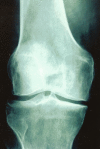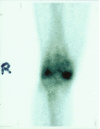The nonoperative treatment of acute, isolated (partial or complete) posterior cruciate ligament-deficient knees: an intermediate-term follow-up study - PubMed (original) (raw)
The nonoperative treatment of acute, isolated (partial or complete) posterior cruciate ligament-deficient knees: an intermediate-term follow-up study
Dipak V Patel et al. HSS J. 2007 Sep.
Abstract
Fifty-seven consecutive patients (58 knees) with an acute, isolated, posterior cruciate ligament (PCL) injury were treated nonoperatively. Clinical, radiographic, and functional assessment was performed at a mean follow-up of 6.9 years (range 2 to 19.3 years) after the initial diagnosis. At the time of initial documentation of the injury, the posterior drawer test was grade A in 17 knees and grade B in 41 knees. The mean preinjury Tegner activity level was 7 (range 4 to 10). At latest follow-up, 38 knees had no pain, 14 had mild pain, and 6 had moderate pain on exertion. Fifty-four knees had no swelling, 3 had mild, intermittent swelling, and 1 had a moderate swelling on exertion. The posterior drawer test was grade A in 14 knees and grade B in 44 knees. The mean Lysholm-II knee score was 85.2 points (range 51 to 100 points) and the mean Tegner activity level was 6.6 (range 3 to 10). Based on Lysholm-II knee scoring system, the results were excellent in 23 knees (40%), good in 30 knees (52%), fair in 2 knees (3%), and poor in 3 knees (5%). No statistically significant correlation (p = 0.097) was seen between the grade of PCL laxity and Lysholm-II knee score. Plain radiographs showed mild (grade I) medial compartment osteoarthritis (OA) in 7 knees, and moderate (grade II) medial compartment OA in 3 knees. Mild patellofemoral OA was seen in 4 knees. We believe that most patients with acute, isolated PCL injuries do well with nonoperative treatment at a mean follow-up of 6.9 years. The level of evidence for this retrospective cohort study is level III.
Figures
Fig. 1
A 24-year-old athlete sustained an isolated grade B PCL injury while playing football. This was treated nonoperatively. At 16.5-years of follow-up, the plain radiograph of the right knee shows grade II (moderate) degenerative changes in the medial compartment
Fig. 2
A 33-year-old male sustained an isolated grade B PCL tear in the right knee while skiing. At initial arthroscopic evaluation, grade III chondral injury was noted in the medial femoral condyle. Because of persistent knee symptoms, a radioisotope bone scan was performed at 32 months after the initial injury. The bone scan shows a moderate focal uptake of the radioactive isotope in the medial femorotibial compartment
Fig. 3
Lysholm-II knee score vs length of follow-up
Similar articles
- Transtibial versus tibial inlay techniques for posterior cruciate ligament reconstruction: long-term follow-up study.
Song EK, Park HW, Ahn YS, Seon JK. Song EK, et al. Am J Sports Med. 2014 Dec;42(12):2964-71. doi: 10.1177/0363546514550982. Epub 2014 Oct 6. Am J Sports Med. 2014. PMID: 25288624 Clinical Trial. - [Experience in diagnosis and treatment of KD- ⅢM dislocation of knee joint].
Zhao Q, Huang J, Hu W, Wu J, Chen X, Ren F, Zheng H, Luo W. Zhao Q, et al. Zhongguo Xiu Fu Chong Jian Wai Ke Za Zhi. 2022 Jan 15;36(1):33-40. doi: 10.7507/1002-1892.202105117. Zhongguo Xiu Fu Chong Jian Wai Ke Za Zhi. 2022. PMID: 35038797 Free PMC article. Chinese. - Injuries to the posterior cruciate ligament and posterolateral instabilities of the knee.
Wang CJ. Wang CJ. Chang Gung Med J. 2002 May;25(5):288-97. Chang Gung Med J. 2002. PMID: 12141701 Review. - Patterns of Compartment Involvement in End-stage Knee Osteoarthritis in a Chinese Orthopedic Center: Implications for Implant Choice.
Wang WJ, Sun MH, Palmer J, Liu F, Bottomley N, Jackson W, Qiu Y, Weng WJ, Price A. Wang WJ, et al. Orthop Surg. 2018 Aug;10(3):227-234. doi: 10.1111/os.12395. Orthop Surg. 2018. PMID: 30152607 Free PMC article. Review.
Cited by
- Surgical management of PCL injuries: indications, techniques, and outcomes.
Montgomery SR, Johnson JS, McAllister DR, Petrigliano FA. Montgomery SR, et al. Curr Rev Musculoskelet Med. 2013 Jun;6(2):115-23. doi: 10.1007/s12178-013-9162-2. Curr Rev Musculoskelet Med. 2013. PMID: 23430587 Free PMC article. - A historical perspective of PCL bracing.
Jansson KS, Costello KE, O'Brien L, Wijdicks CA, Laprade RF. Jansson KS, et al. Knee Surg Sports Traumatol Arthrosc. 2013 May;21(5):1064-70. doi: 10.1007/s00167-012-2048-9. Epub 2012 May 24. Knee Surg Sports Traumatol Arthrosc. 2013. PMID: 22622778 Review. - Suture Tape-Augmented Posterior Cruciate Ligament Repair Should Be Tensioned and Fixed at Approximately 100° Knee Flexion to Prevent Loss of Full Flexion.
Ostrander R, Jordan S, Konicek J, Baldwin W. Ostrander R, et al. Arthrosc Sports Med Rehabil. 2021 Oct 29;3(6):e1811-e1818. doi: 10.1016/j.asmr.2021.08.008. eCollection 2021 Dec. Arthrosc Sports Med Rehabil. 2021. PMID: 34977635 Free PMC article. - An evaluation of posterior cruciate ligament reconstruction surgery.
Razi M, Ghaffari S, Askari A, Arasteh P, Ziabari EZ, Dadgostar H. Razi M, et al. BMC Musculoskelet Disord. 2020 Aug 8;21(1):526. doi: 10.1186/s12891-020-03533-6. BMC Musculoskelet Disord. 2020. PMID: 32770989 Free PMC article. - The effect of a dynamic PCL brace on patellofemoral compartment pressures in PCL-and PCL/PLC-deficient knees.
Welch T, Keller T, Maldonado R, Metzger M, Mohr K, Kvitne R. Welch T, et al. J Exp Orthop. 2017 Dec;4(1):10. doi: 10.1186/s40634-017-0085-5. Epub 2017 Mar 31. J Exp Orthop. 2017. PMID: 28361277 Free PMC article.
References
- {'text': '', 'ref_index': 1, 'ids': [{'type': 'PubMed', 'value': '13630767', 'is_inner': True, 'url': 'https://pubmed.ncbi.nlm.nih.gov/13630767/'}\]}
- O’Donoghue DH (1959) Surgical treatment of injuries to ligaments of the knee. JAMA 169(13):1423–1431 - PubMed
- {'text': '', 'ref_index': 1, 'ids': [{'type': 'PubMed', 'value': '24822488', 'is_inner': True, 'url': 'https://pubmed.ncbi.nlm.nih.gov/24822488/'}\]}
- Clendenin MB, DeLee JC, Heckman JD (1980) Interstitial tears of the posterior cruciate ligament of the knee. Orthopedics 3:764–772 - PubMed
- {'text': '', 'ref_index': 1, 'ids': [{'type': 'DOI', 'value': '10.1177/036354658000800102', 'is_inner': False, 'url': 'https://doi.org/10.1177/036354658000800102'}, {'type': 'PubMed', 'value': '6892543', 'is_inner': True, 'url': 'https://pubmed.ncbi.nlm.nih.gov/6892543/'}\]}
- DeHaven KE (1980) Diagnosis of acute knee injuries with hemarthrosis. Am J Sports Med 8(1):9–14 - PubMed
- {'text': '', 'ref_index': 1, 'ids': [{'type': 'PubMed', 'value': '7204432', 'is_inner': True, 'url': 'https://pubmed.ncbi.nlm.nih.gov/7204432/'}\]}
- Lysholm J, Gillquist J (1981) Arthroscopic examination of the posterior cruciate ligament. J Bone Joint Surg [Am] 63-A(3):363–366 - PubMed
- {'text': '', 'ref_index': 1, 'ids': [{'type': 'PubMed', 'value': '7073822', 'is_inner': True, 'url': 'https://pubmed.ncbi.nlm.nih.gov/7073822/'}\]}
- Hughston JC, Degenhardt TC (1982) Reconstruction of the posterior cruciate ligament. Clin Orthop Relat Res 164:59–77 - PubMed
LinkOut - more resources
Full Text Sources


